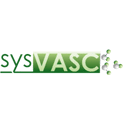EU-Funded Project

Abbreviation:
SysVasc
Title:
Systems Biology to Identify Molecular Targets for Vascular Disease Treatment.
In short:
Applying “omics”-technologies to identify targets for vascular disease treatment.
Tags:
Human R&D, Project Management


Project Details
Funding scheme:
FP7-HEALTH-2013-INNOVATION-1 – Grant Agreement ID 603288
Time frame:
1 February 2014 to 31 January 2018
Weblink:
https://www.sysvasc.eu/
CORDIS: https://cordis.europa.eu/project/id/603288
Description:
Cardiovascular disease (CVD) is the leading cause of mortality and morbidity in Europe and worldwide. Asymptomatic vascular damage accumulates for years before patients are identified and subjected to therapeutic measures. The limited knowledge on early vascular disease pathophysiology is reflected in the lack of therapeutic options. Prognostic biomarkers remain widely elusive and personalized risk assessment relies on rough estimates based on traditional risk factors. The underlying pathophysiological changes remain incompletely understood. The main clinical needs faced in CVD are: 1) a better understanding of the key pathogenic factors involved in the progression of CVD independent of etiology, 2) the diagnosis of asymptomatic disease and 3) the prediction and prevention of cardiovascular events. The sysVASC project aimed to overcome these limitations by identifying pathophysiological mechanisms and key molecules responsible for onset and progression of CVD and validation of their potential to serve as molecular targets for therapeutic intervention. The sysVASC consortium, gathering a wide range of experts in the field of different “omics” technologies, systems biology, statistics, cardiovascular diseases and preclinical studies, provided a unique know-how necessary to break through current challenges in the field of CVD. Within the consortium, GenomeScan performed multiple Whole Genome Sequencing (WGS) experiments and led the Intellectual Property (IP) Management and Exploitation efforts.
Acknowledgements:


